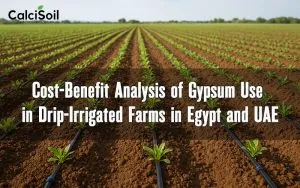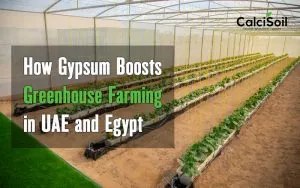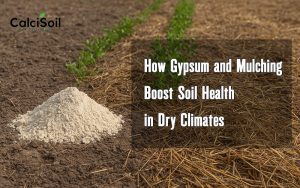
Gypsum, or calcium sulfate, is commonly used as a soil amendment to improve clay soils, particularly in agricultural and gardening contexts. Its primary benefits stem from its ability to enhance soil structure and drainage.
Benefits of Gypsum for Clay Soil
- Improves Soil Structure: Gypsum helps aggregate clay particles, allowing them to clump together into larger structures. This process, known as flocculation, improves soil aeration and water infiltration, making it easier for roots to penetrate and access nutrients.
- Reduces Sodium Levels: In sodic soils, where sodium ions disrupt the clay structure, gypsum replaces sodium with calcium. This exchange helps to wash sodium deeper into the soil profile, improving drainage and reducing soil stickiness when wet.
- Adds Calcium and Sulfur: Gypsum provides both calcium and sulfur, which are essential for plant growth. While it does not significantly alter soil pH, it can be beneficial in soils that require additional calcium without the need to raise pH levels.
- Short-Term Effects: The effects of gypsum are generally short-lived, often lasting a few months. Regular applications may be necessary to maintain its benefits, especially in heavily compacted soils
- Not a Miracle Solution: While gypsum can improve certain soil conditions, it is not a cure-all. It is most effective in soils that are high in sodium or have specific compaction issues. Soil testing is recommended to determine if gypsum is appropriate for your specific conditions
Application Guidelines
– Rate of Application: A common recommendation is to apply about 40 pounds of gypsum per 1,000 square feet of soil. This can be done using a lawn spreader or by hand, depending on the area size.
– Timing: Gypsum can be applied at any time of the year. However, watering immediately after application can help activate its effects
– Complementary Practices: For best results, combine gypsum application with organic matter additions, such as compost, to enhance soil health and structure over time.
In summary, agricultural gypsum can be a valuable tool for improving clay soils, particularly in sodic conditions, but it should be used judiciously and in conjunction with other soil management practices.
How much gypsum should I apply to clay soil?

The application rate of gypsum for clay soil can vary based on specific conditions and requirements. Here are some general guidelines:
- General Application Rates: For soil conditioning, a common recommendation is to apply gypsum at rates of 0.5 to 1 ton per hectare (approximately 1,000 to 2,000 pounds per acre) for general use. Higher rates, up to 5 tons per hectare, may be beneficial for improving clay soils, especially in preparation for crops like canola or cereals.
- Specific Recommendations:
– For heavy clay soils, applying 2 kg per square meter (approximately 4,000 pounds per acre) is suggested to break down the clay effectively.
– A more conservative approach suggests using 500 grams per square meter (about 1,000 pounds per acre) for general soil conditioning.
– For smaller areas or gardens, applying two to three handfuls per square meter is also recommended, which can be mixed into the soil.
- Frequency of Application: Gypsum can be reapplied annually for several years to maintain its benefits, particularly in areas with persistent clay issues
- Soil Testing: It is advisable to conduct a soil test before application to determine the specific nutrient needs and existing conditions of your soil. This helps tailor the gypsum application more effectively to your soil’s requirements.
Totally, for clay soil, start with an application of 0.5 to 1 ton per hectare and adjust based on soil conditions and crop needs, ensuring to reapply as necessary for ongoing improvement.
Factors should be considered before applying gypsum
Before applying gypsum to clay soil, several factors should be considered to ensure its effectiveness and appropriateness for your specific conditions:
- Soil Type and Condition
Sodic vs. Non-Sodic Soil: Gypsum is particularly effective in sodic soils where sodium disrupts the clay structure. It helps to displace sodium ions with calcium, improving soil structure and drainage. In non-sodic clay soils, gypsum may not provide significant benefits.
Soil Testing: Conduct a soil test to determine existing calcium levels and pH. If your soil already has sufficient calcium, adding gypsum may not be necessary and could lead to excess calcium accumulation.
- Application Method
Mixing: Gypsum should be thoroughly mixed into the soil to enhance its effectiveness. For best results, apply it before planting and ensure it is well incorporated to reach the root zone.
Watering: If the clay soil is dry, watering after application can help activate the gypsum and facilitate its penetration into the soil.
- Rate and Frequency of Application
Recommended Rates: Typical application rates range from 0.5 to 2 kg per square meter depending on soil conditions. For heavy clay, higher rates may be necessary.
Reapplication: The effects of gypsum are often short-lived, lasting only a few months. Regular reapplication may be needed, especially in heavily compacted or sodic soils.
- Complementary Practices
Organic Matter: Incorporating organic matter, such as compost, can further improve soil structure and fertility. Gypsum is most effective when used in conjunction with organic amendments.
Compaction Issues: Gypsum does not resolve compaction issues directly. Physical methods like aeration may be necessary to alleviate compacted soil conditions.
Economic Considerations: Weigh the cost of gypsum against its potential benefits. In some cases, improving soil with organic matter might be more cost-effective and beneficial in the long term.
- Specific Crop Needs
Crop Type: Different crops may have varying requirements for calcium and soil structure. Consider the specific needs of the plants you intend to grow when deciding on gypsum application.
In summary, a thorough assessment of soil type, testing, application methods, and complementary practices will help determine the appropriateness of gypsum for your clay soil.
As additional tips, we suggest you read this article about “How quickly does gypsum work“.







